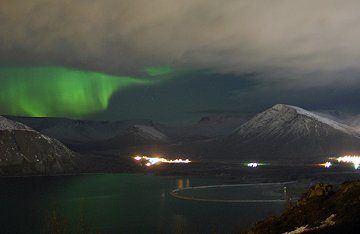From Nasa's Space Weather. It looks like they're doing something right.
A small, newly-discovered asteroid named 2008 TC3 is approaching Earth and chances are better than 99.8% that it will hit. Steve Chesley of NASA's Jet Propulsion Laboratory estimates that atmospheric entry will occur on Oct 7th at 0246 UTC over northern Sudan--just hours from now. Measuring only a few meters across, the space rock poses NO THREAT to people or structures on the ground, but it should create a spectacular fireball, releasing about a kiloton of TNT in energy as it disintegrates and explodes in the atmosphere. Asteroids of this size hit Earth every few months, but this is the first time one has been discovered before it hit.
It Never Rains in Southern Russia!

Saturday night, Oct. 4th, in Russia's Kolyskia peninsula, storm clouds gathered over Mt. Khibiny and the rain began to fall. Lo and behold, it was green.
Northern Lights posing as rain are a common occurance in this arctic part of Russia, where photographer Aleksander Chernucho keeps his Nikon D200 close at hand for midnight photo-ops. On this night, the clouds pulled back revealing a bank of auroras so bright they turned the harbor waters as green as the sky: photo. "Good storm!"
Earth is exiting the solar wind stream that caused the display, but another stream is on the way. Sky watchers around the Arctic Circle should be alert for auroras when it arrives on Oct. 8th or 9th.
As the Rover Roves
Sorry, they only had a 3D pic. Get out your Secret Agent Decoder Glasses to see it.
After spending a year inside Victoria Crater, Mars rover Opportunity has climbed out and resumed its travels across the red planet. Put on your 3D glasses and enjoy this view of one small crater near the rim of receding Victoria:

Graphic artist Patrick Vantuyne created the anaglyph by combining right- and left-eye images from Opportunity's stereo camera. The complete panorama, showing the entirety of Victoria crater in the background, is a must-see.
Next stop: Endeavor, a 14-mile wide crater some 20 times larger than Victoria. To get there, Opportunity will have to drive seven miles, matching the total distance it has traveled since landing on Mars in early 2004. The journey could take two years. "We may not make it, but scientifically speaking that's the right direction to go," says Steve Squyres of Cornell University. "Endeavour is staggeringly large compared to anything we've seen before." Squyres and colleagues hope that peering into the depths of Endeavour will yield new secrets from Mars' wet and wild past--and, oh, the 3D!
Two More Aurorae


--->Susan


3 comments:
Thanks for the pretty pics. And it is comforting to know that if we're all going to die by meteor, NASA will at least be able to tell us in advance.
Yes, quite. At least it's not one of those asteroids that require Bruce and Ben to drill it in half. I mean, would you feel comfortable knowing that the survival of our race rested with one half of the team being of the Affleck persuasion?
And yes, pretty, pretty lights.
There are preliminary reports that a meteor was spotted over the Sudan last night so scientists working on the NEO project are ecstatic.
--->Susan
Post a Comment